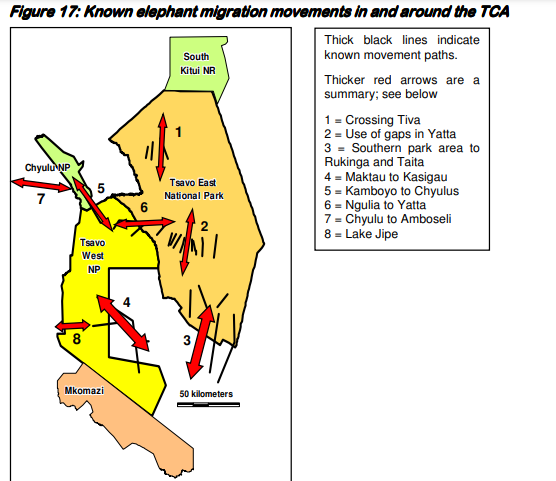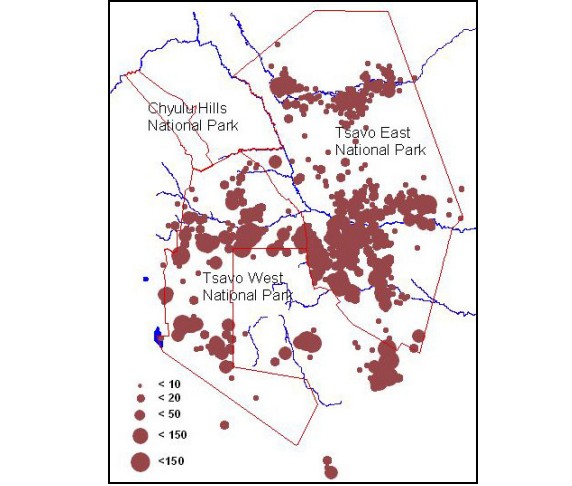Tsavo East National Park is renowned for its elephant population, especially its distinctive red elephants that have become iconic around the world. This unique feature, along with Tsavo East’s vast landscapes and thriving wildlife, makes the park an essential destination for elephant enthusiasts. In this comprehensive guide, we’ll delve into the history, significance, behavior, and conservation of Tsavo East’s elephants, offering you a detailed understanding of these incredible creatures.

1. Tsavo East: A Haven for Elephants
Tsavo East National Park, one of the largest wildlife reserves in Kenya, spans an area of 13,747 km² and serves as a vital sanctuary for a significant portion of the country’s elephant population. The park’s diverse ecosystems—ranging from open savannahs to riverine forests—provide ideal conditions for elephants, offering a mix of water sources, feeding grounds, and secluded areas for their herds.
2. The Iconic Red Elephants of Tsavo East
One of the most striking characteristics of the elephants in Tsavo East is their reddish-brown appearance, which has made them world-famous. These elephants get their unique color by rolling in the park’s red volcanic soil, which gives them a dusty, reddish tint. This behavior is not just for aesthetics—dust baths serve a vital purpose in protecting their skin from the sun and insects. The red elephants are a trademark of Tsavo East and are symbolic of the park’s rugged beauty and diverse wildlife.
- Why Red?: The elephants are particularly known for their thick, red dust coats. After their dust baths, the elephants often appear as if they’ve been covered in red clay, which is a natural sunblock and a way to repel biting insects.
- Elephant Behavior: The red elephants are highly social animals, often traveling in large herds of 10-20 members, led by a matriarch. Their bonding behavior is strong, and their relationships with family members and other elephants are complex, relying on communication and cooperation.
3. Elephant Population and Ecology in Tsavo East

Tsavo East is home to one of the largest elephant populations in Kenya, with the park supporting several thousand individuals. The elephants play a crucial role in the park’s ecology and have a major impact on the landscape.
- Population Numbers: While the exact number of elephants in Tsavo East fluctuates, estimates suggest that over 10,000 elephants inhabit the park, making it a key sanctuary for the species.
- Habitat and Movement: Elephants in Tsavo East are nomadic, and their movements are guided by the availability of water and food. Their natural migratory behavior sees them traveling across the park’s vast plains and river systems, from the Voi River to Galana River, and often venturing into Tsavo West and even crossing into Tanzania.
- Ecological Role: Elephants are considered keystone species due to their profound impact on the ecosystem. Their feeding habits help shape the landscape by breaking trees and bushes, which creates open spaces and helps maintain the park’s biodiversity. Additionally, elephants contribute to the fertility of the soil through the dispersal of seeds and manure.
4. Tsavo East’s Elephant Conservation Efforts
Tsavo East has been at the forefront of elephant conservation efforts in Kenya, with various initiatives in place to protect these majestic creatures. These include active management programs, anti-poaching patrols, and collaborations with local communities.
1. Anti-Poaching Initiatives
- Poaching Threats: In the past, Tsavo East has struggled with elephant poaching, driven primarily by the demand for ivory. The Ivory Trade Ban has helped reduce poaching, but elephants in the region still face risks from illegal hunting and habitat loss.
- Conservation Measures: The Kenya Wildlife Service (KWS), alongside local and international conservation organizations, has implemented anti-poaching operations in Tsavo East, utilizing rangers, drone surveillance, and tracking technology to monitor and protect elephants from poachers.
2. Elephant Protection Programs
- Tsavo Elephant Trust: The Tsavo Elephant Trust is a key player in elephant conservation within the park. This organization focuses on research, monitoring, and protecting elephant populations in the Tsavo region.
- Collaring and Monitoring: Elephants in the park are monitored through GPS collaring and tracking systems to gather data on their movements and behavior. This information helps in conservation planning, ensuring that elephants have safe migratory routes and adequate resources.
- Community Engagement: Collaborations with local communities are essential to protecting elephants. Programs that encourage community involvement, such as beekeeping (which reduces human-wildlife conflict) and eco-tourism initiatives, help foster peaceful coexistence between humans and elephants.
5. Elephant Behavior and Social Structure
Elephants in Tsavo East exhibit fascinating social behaviors and have a highly organized social structure, which is largely influenced by the matriarch. These herds are typically matrilineal, meaning that the oldest female elephant leads the group, making decisions for the entire family.
- Communication: Elephants communicate using a wide range of sounds, from trumpets and rumbles to vibrations detected through the ground. They also use visual cues, such as ear movements and body posture, to convey messages.
- Family Structure: A typical elephant herd in Tsavo East consists of multiple generations, from mothers and young calves to older females. Bulls tend to leave the herd after reaching maturity, becoming solitary or forming small bachelor groups.
- Mating and Calf Rearing: Elephant calves are born after a lengthy 22-month gestation period, and mothers are extremely protective of their young. Calves rely heavily on the maternal bond for survival during their early years, with other herd members playing an important role in the protection and care of the young.
6. Key Elephant Viewing Locations in Tsavo East

Tsavo East offers fantastic opportunities for elephant sightings, especially at specific waterholes and river crossings. Some of the prime locations to view elephants include:
- Voi River: One of the main sources of water for elephants, particularly during the dry season when herds converge around the river for drinking and bathing.
- Aruba Dam: A popular elephant hotspot, where large herds of elephants can be observed drinking, playing, and interacting in the water.
- Galana River: The river also attracts elephants and is a prime area for game drives and wildlife photography.
- Manyatta Camp Area: Located near the Voi River, this area is well-known for close elephant encounters. It is a great spot for early morning and evening game drives.
7. Best Time to Visit for Elephant Viewing
The best time to visit Tsavo East for elephant viewing is during the dry season from June to October. During this period, elephants and other wildlife congregate around water sources, making them easier to spot. However, the wet season (November to May) can also be a rewarding time for birdwatching and capturing the park’s lush green landscapes.
Elephant Movements in TCA
The elephant migration patterns in and around the Tsavo Conservation Area (TCA) are essential for the conservation and ecology of the region, as shown in the map below. Elephants are known to follow specific migration routes across vast areas, often moving between the park’s boundaries and beyond. The map identifies eight primary migration paths, with thicker red arrows summarizing the key movement corridors, and thick black lines marking known movement paths.

Some of the key elephant migration routes include:
- Crossing Tiva: Elephants cross the Tiva River, a vital route for moving between different parts of the park.
- Use of gaps in Yatta: Elephants utilize natural gaps in the Yatta Plateau to traverse between Tsavo East and Tsavo West.
- Southern Park area to Rukinga and Taita: A significant migration route that leads southward towards Rukinga and the Taita Hills, crucial for the long-distance movements of the elephants.
- Maktau to Kasigau: This route links Maktau with the Kasigau Hills, another important passage.
- Kamboyo to Chyulus: Connecting Kamboyo with Chyulu Hills, this path is vital for elephant dispersal in the region.
- Ngulia to Yatta: A movement path from Ngulia to Yatta, allowing elephants to move between Tsavo West and Tsavo East.
- Chyulu to Amboseli: This route connects Chyulu Hills to Amboseli National Park, facilitating the migration of elephants from Tsavo East to the Amboseli ecosystem.
- Lake Jipe: A lesser-known route heading towards Lake Jipe, which provides access to vital water sources for elephants during the dry season.
These migration routes are becoming increasingly important due to human encroachment and intensifying farming practices in the region, which continue to disrupt the natural movement of elephants. The Taita and Rukinga Hills areas, in particular, are facing severe challenges as human settlements interfere with traditional elephant paths.
8. Conclusion
The elephants of Tsavo East are not just a highlight of the park—they are an essential part of its ecosystem, helping to shape the landscape and maintain biodiversity. With a rich history of conservation efforts, including the Tsavo Elephant Trust and anti-poaching initiatives, the park continues to provide a safe haven for these magnificent creatures. Whether you are a wildlife enthusiast, a photographer, or simply a nature lover, Tsavo East offers a unique and rewarding opportunity to witness elephants in their natural habitat, making it an unforgettable part of any safari in Kenya.
